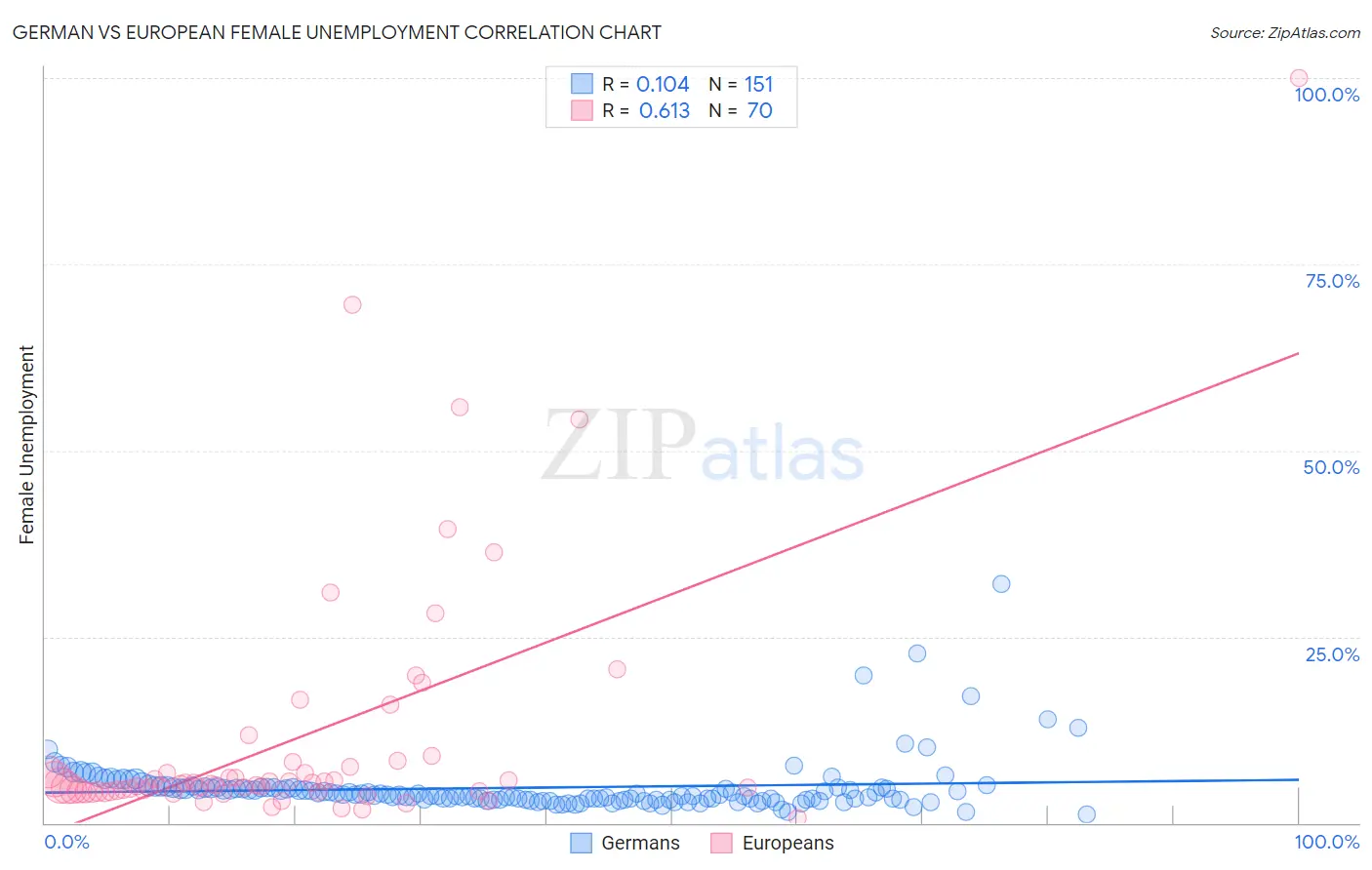German vs European Female Unemployment
COMPARE
German
European
Female Unemployment
Female Unemployment Comparison
Germans
Europeans
4.5%
FEMALE UNEMPLOYMENT
100.0/ 100
METRIC RATING
8th/ 347
METRIC RANK
4.7%
FEMALE UNEMPLOYMENT
99.9/ 100
METRIC RATING
22nd/ 347
METRIC RANK
German vs European Female Unemployment Correlation Chart
The statistical analysis conducted on geographies consisting of 564,194,310 people shows a poor positive correlation between the proportion of Germans and unemploymnet rate among females in the United States with a correlation coefficient (R) of 0.104 and weighted average of 4.5%. Similarly, the statistical analysis conducted on geographies consisting of 549,789,782 people shows a significant positive correlation between the proportion of Europeans and unemploymnet rate among females in the United States with a correlation coefficient (R) of 0.613 and weighted average of 4.7%, a difference of 4.5%.

Female Unemployment Correlation Summary
| Measurement | German | European |
| Minimum | 1.1% | 0.60% |
| Maximum | 32.1% | 100.0% |
| Range | 31.0% | 99.4% |
| Mean | 4.7% | 11.3% |
| Median | 3.8% | 5.2% |
| Interquartile 25% (IQ1) | 3.2% | 4.3% |
| Interquartile 75% (IQ3) | 4.7% | 7.6% |
| Interquartile Range (IQR) | 1.5% | 3.3% |
| Standard Deviation (Sample) | 3.7% | 17.0% |
| Standard Deviation (Population) | 3.6% | 16.9% |
Demographics Similar to Germans and Europeans by Female Unemployment
In terms of female unemployment, the demographic groups most similar to Germans are Chinese (4.5%, a difference of 0.020%), Slovene (4.5%, a difference of 0.36%), Swedish (4.4%, a difference of 0.79%), Swiss (4.6%, a difference of 1.7%), and Scandinavian (4.6%, a difference of 1.8%). Similarly, the demographic groups most similar to Europeans are Fijian (4.7%, a difference of 0.020%), Bulgarian (4.7%, a difference of 0.030%), Polish (4.7%, a difference of 0.11%), Latvian (4.7%, a difference of 0.12%), and Croatian (4.7%, a difference of 0.26%).
| Demographics | Rating | Rank | Female Unemployment |
| Hmong | 100.0 /100 | #5 | Exceptional 4.4% |
| Swedes | 100.0 /100 | #6 | Exceptional 4.4% |
| Chinese | 100.0 /100 | #7 | Exceptional 4.5% |
| Germans | 100.0 /100 | #8 | Exceptional 4.5% |
| Slovenes | 100.0 /100 | #9 | Exceptional 4.5% |
| Swiss | 100.0 /100 | #10 | Exceptional 4.6% |
| Scandinavians | 100.0 /100 | #11 | Exceptional 4.6% |
| Dutch | 100.0 /100 | #12 | Exceptional 4.6% |
| Belgians | 100.0 /100 | #13 | Exceptional 4.6% |
| Finns | 100.0 /100 | #14 | Exceptional 4.6% |
| English | 100.0 /100 | #15 | Exceptional 4.6% |
| Carpatho Rusyns | 99.9 /100 | #16 | Exceptional 4.7% |
| Croatians | 99.9 /100 | #17 | Exceptional 4.7% |
| Latvians | 99.9 /100 | #18 | Exceptional 4.7% |
| Poles | 99.9 /100 | #19 | Exceptional 4.7% |
| Bulgarians | 99.9 /100 | #20 | Exceptional 4.7% |
| Fijians | 99.9 /100 | #21 | Exceptional 4.7% |
| Europeans | 99.9 /100 | #22 | Exceptional 4.7% |
| Scottish | 99.9 /100 | #23 | Exceptional 4.7% |
| Welsh | 99.9 /100 | #24 | Exceptional 4.7% |
| Immigrants | India | 99.9 /100 | #25 | Exceptional 4.7% |